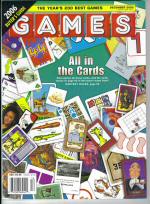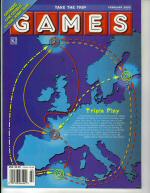THE KITES AND DARTS GAME
Designer: Nancy J. van Schooenderwoert
Players: 2-5. Playing Time: 45 min.
Back in the 1970s, English mathematician Roger Penrose discovered a pair of shapes that can be used to tile a plane in a manner that exhibits the strange property of quasiperiodicity. Even though (on an infinite plane) any finite section of the tiling repeats an infinite number of times, the tiling pattern as a whole never repeats—meaning that if you could duplicate all the tiles, pick them up, and move them as a group, you would not be able to find a new place to put them back down that would match the original pattern. Later, English mathematician John Horton Conway obligingly called these shapes, both formed by two joined isosceles triangles, "kites" and "darts."
Kadon Enterprises, a longtime seller of kites and darts, now offers us a game using those shapes. A mat with an outline of a Penrose tiling serves as the playing board. The goal is to be the player with the fewest tiles left when the board is entirely filled.
Choose for play three of the five colors provided. Players get five kites and five darts in each color, plus one of the three Island Tokens, depending on the number of players. The first player places a tile on the board and continues by playing more tiles next to previously placed ones so that no pair of adjacent tiles shares the same color. Eventually, a tile will become "forced," meaning that only one color can be played in a particular space. Play passes to the next person, who will play one or more forced tiles, followed by at least one unforced tile. Discarding an Island Token lets you place a tile without touching another—a useful way to extend turns that seem much too short. A player who runs out of a needed type of tile draws five new ones, and opponents simultaneously draw five of any type.
It may happen that a hole forms in which no tile is legally playable. In this case, an intriguing sequence of moves called Patch Play occurs, in which some tile colors are changed so that the hole can accommodate a new type of tile. Kadon thoughtfully provides a suction tool that can remove pieces without disturbing others.
With its visual appeal, The Kites and Darts game flies high in a gorgeous realm and also offers plenty of complex challenges.
—Robin H. King

